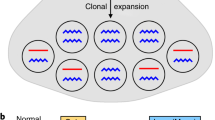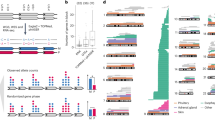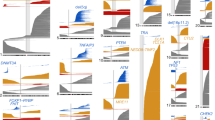Abstract
In an analysis of 31,717 cancer cases and 26,136 cancer-free controls from 13 genome-wide association studies, we observed large chromosomal abnormalities in a subset of clones in DNA obtained from blood or buccal samples. We observed mosaic abnormalities, either aneuploidy or copy-neutral loss of heterozygosity, of >2 Mb in size in autosomes of 517 individuals (0.89%), with abnormal cell proportions of between 7% and 95%. In cancer-free individuals, frequency increased with age, from 0.23% under 50 years to 1.91% between 75 and 79 years (P = 4.8 × 10−8). Mosaic abnormalities were more frequent in individuals with solid tumors (0.97% versus 0.74% in cancer-free individuals; odds ratio (OR) = 1.25; P = 0.016), with stronger association with cases who had DNA collected before diagnosis or treatment (OR = 1.45; P = 0.0005). Detectable mosaicism was also more common in individuals for whom DNA was collected at least 1 year before diagnosis with leukemia compared to cancer-free individuals (OR = 35.4; P = 3.8 × 10−11). These findings underscore the time-dependent nature of somatic events in the etiology of cancer and potentially other late-onset diseases.
This is a preview of subscription content, access via your institution
Access options
Subscribe to this journal
Receive 12 print issues and online access
$209.00 per year
only $17.42 per issue
Buy this article
- Purchase on Springer Link
- Instant access to full article PDF
Prices may be subject to local taxes which are calculated during checkout



Similar content being viewed by others
References
Youssoufian, H. & Pyeritz, R.E. Mechanisms and consequences of somatic mosaicism in humans. Nat. Rev. Genet. 3, 748–758 (2002).
Notini, A.J., Craig, J.M. & White, S.J. Copy number variation and mosaicism. Cytogenet. Genome Res. 123, 270–277 (2008).
Hsu, L.Y. et al. Proposed guidelines for diagnosis of chromosome mosaicism in amniocytes based on data derived from chromosome mosaicism and pseudomosaicism studies. Prenat. Diagn. 12, 555–573 (1992).
Menten, B. et al. Emerging patterns of cryptic chromosomal imbalance in patients with idiopathic mental retardation and multiple congenital anomalies: a new series of 140 patients and review of published reports. J. Med. Genet. 43, 625–633 (2006).
Lu, X.Y. et al. Genomic imbalances in neonates with birth defects: high detection rates by using chromosomal microarray analysis. Pediatrics 122, 1310–1318 (2008).
Conlin, L.K. et al. Mechanisms of mosaicism, chimerism and uniparental disomy identified by single nucleotide polymorphism array analysis. Hum. Mol. Genet. 19, 1263–1275 (2010).
Heim, S. & Mitelman, F. Nonrandom chromosome abnormalities in cancer—an overview. in Cancer Cytogenetics (eds. Mitelman, F. & Heim, S.) (John Wiley & Sons, Hoboken, New Jersey, 2009).
Tuna, M., Knuutila, S. & Mills, G.B. Uniparental disomy in cancer. Trends Mol. Med. 15, 120–128 (2009).
Solomon, D.A. et al. Mutational inactivation of STAG2 causes aneuploidy in human cancer. Science 333, 1039–1043 (2011).
Rio Frio, T. et al. Homozygous BUB1B mutation and susceptibility to gastrointestinal neoplasia. N. Engl. J. Med. 363, 2628–2637 (2010).
Snape, K. et al. Mutations in CEP57 cause mosaic variegated aneuploidy syndrome. Nat. Genet. 43, 527–529 (2011).
Amary, M.F. et al. Ollier disease and Maffucci syndrome are caused by somatic mosaic mutations of IDH1 and IDH2. Nat. Genet. 43, 1262–1265 (2011).
Pansuriya, T.C. et al. Somatic mosaic IDH1 and IDH2 mutations are associated with enchondroma and spindle cell hemangioma in Ollier disease and Maffucci syndrome. Nat. Genet. 43, 1256–1261 (2011).
Hafner, C., Toll, A. & Real, F.X. HRAS mutation mosaicism causing urothelial cancer and epidermal nevus. N. Engl. J. Med. 365, 1940–1942 (2011).
Forsberg, L.A. et al. Age-related somatic structural changes in the nuclear genome of human blood cells. Am. J. Hum. Genet. 90, 217–228 (2012).
Rodíguez-Santiago, B. et al. Mosaic uniparental disomies and aneuploidies as large structural variants of the human genome. Am. J. Hum. Genet. 87, 129–138 (2010).
González, J.R. et al. A fast and accurate method to detect allelic genomic imbalances underlying mosaic rearrangements using SNP array data. BMC Bioinformatics 12, 166 (2011).
Pique-Regi, R., Caceres, A. & Gonzalez, J.R. R-Gada: a fast and flexible pipeline for copy number analysis in association studies. BMC Bioinformatics 11, 380 (2010).
Hedrick, P.W. Sex: differences in mutation, recombination, selection, gene flow, and genetic drift. Evolution 61, 2750–2771 (2007).
Döhner, H. et al. Genomic aberrations and survival in chronic lymphocytic leukemia. N. Engl. J. Med. 343, 1910–1916 (2000).
Lanasa, M.C. et al. Immunophenotypic and gene expression analysis of monoclonal B-cell lymphocytosis shows biologic characteristics associated with good prognosis CLL. Leukemia 25, 1459–1466 (2011).
Forbes, S.A. et al. COSMIC: mining complete cancer genomes in the Catalogue of Somatic Mutations in Cancer. Nucleic Acids Res. 39, D945–D950 (2011).
Benetatos, L., Vartholomatos, G. & Hatzimichael, E. MEG3 imprinted gene contribution in tumorigenesis. Int. J. Cancer 129, 773–779 (2011).
Lee, S. et al. Forerunner genes contiguous to RB1 contribute to the development of in situ neoplasia. Proc. Natl. Acad. Sci. USA 104, 13732–13737 (2007).
Migliazza, A. et al. Nucleotide sequence, transcription map, and mutation analysis of the 13q14 chromosomal region deleted in B-cell chronic lymphocytic leukemia. Blood 97, 2098–2104 (2001).
Pekarsky, Y., Zanesi, N. & Croce, C.M. Molecular basis of CLL. Semin. Cancer Biol. 20, 370–376 (2010).
Gurvich, N. et al. L3MBTL1 polycomb protein, a candidate tumor suppressor in del(20q12) myeloid disorders, is essential for genome stability. Proc. Natl. Acad. Sci. USA 107, 22552–22557 (2010).
Laurie, C.C. et al. Detectable clonal mosaicism from birth to old age and its relationship to cancer. Nat. Genet. published online, doi:10.1038/ng.2271 (6 May 2012).
Pinto, D. et al. Comprehensive assessment of array-based platforms and calling algorithms for detection of copy number variants. Nat. Biotechnol. 29, 512–520 (2011).
Dellinger, A.E. et al. Comparative analyses of seven algorithms for copy number variant identification from single nucleotide polymorphism arrays. Nucleic Acids Res. 38, e105 (2010).
Marenne, G. et al. Assessment of copy number variation using the Illumina Infinium 1M SNP-array: a comparison of methodological approaches in the Spanish Bladder Cancer/EPICURO study. Hum. Mutat. 32, 240–248 (2011).
Cancer Genome Atlas Research Network. Comprehensive genomic characterization defines human glioblastoma genes and core pathways. Nature 455, 1061–1068 (2008).
Hudson, T.J . et al. International network of cancer genome projects. Nature 464, 993–998 (2010).
Sahin, E. & Depinho, R.A. Linking functional decline of telomeres, mitochondria and stem cells during ageing. Nature 464, 520–528 (2010).
Petersen, G.M. et al. A genome-wide association study identifies pancreatic cancer susceptibility loci on chromosomes 13q22.1, 1q32.1 and 5p15.33. Nat. Genet. 42, 224–228 (2010).
Staaf, J. et al. Normalization of Illumina Infinium whole-genome SNP data improves copy number estimates and allelic intensity ratios. BMC Bioinformatics 9, 409 (2008).
Diskin, S.J. et al. Adjustment of genomic waves in signal intensities from whole-genome SNP genotyping platforms. Nucleic Acids Res. 36, e126 (2008).
Peiffer, D.A. et al. High-resolution genomic profiling of chromosomal aberrations using Infinium whole-genome genotyping. Genome Res. 16, 1136–1148 (2006).
Itsara, A. et al. Population analysis of large copy number variants and hotspots of human genetic disease. Am. J. Hum. Genet. 84, 148–161 (2009).
Akaike, H. A new look at the statistical model identification. IEEE Trans. Automat. Contr. 19, 716–723 (1974).
Krzywinski, M. et al. Circos: an information aesthetic for comparative genomics. Genome Res. 19, 1639–1645 (2009).
Agresti, A. & Coull, B.A. Approximate is better than “exact” for interval estimation of binomial proportions. Am. Stat. 52, 119–126 (1998).
Frazer, K.A. et al. A second generation human haplotype map of over 3.1 million SNPs. Nature 449, 851–861 (2007).
Acknowledgements
This research was supported by the Intramural Research Program and by contract number HHSN261200800001E of the US National Institutes of Health (NIH), NCI. Support for each contributing study is listed in the Supplementary Note. We thank C. Laurie and B. Weir for constructive discussion and a comparison of methodology and results for the GENEVA study. The findings and conclusions in this report are those of the authors and do not necessarily represent the views of the National Cancer Institute, the National Institute for Occupational Safety and Health or the Maryland Cancer Registry.
Author information
Authors and Affiliations
Contributions
K.B.J., M.Y., W. Zhou, Z.W., X.D., C.L., S.W., N.E.C., M.T., N.R. and S.J.C. designed the study. K.B.J., M.Y., L.A.P.-J., W. Zhou, Z.W., S.W., N.E.C., N.R., M. Cullen, M.C.D., D.A., B.I.G., R.N.H., F.X.R. and S.J.C. interpreted the primary results. K.B.J., M.Y., L.A.P.-J., B.R.-S. and J.R.G. developed the study methods. K.B.J., M.Y., L.A.P.-J., W. Zhou, Z.W., X.D., C.L., M. Cullen, C.G.E., M.C.D., N.C., J.S. and C.C.C. analyzed the data. K.B.J., M.Y., W. Zhou, Z.W., X.D., C.L., A.H., L.B. and J.K. were responsible for production and analysis of the genotype data. K.B.J., M.Y. and S.W. performed statistical analysis. K.B.J., M.Y., S.W., M.-J.H. and S.J.C. drafted the manuscript. M.T., R.N.H., S.J.C. and J.F.F. provided vital programmatic and institutional support. J.R.G., N.E.C., M.T., N.R., S.J.C., S.M.G., V.L.S., L.T.T., M.M.G., D.A., S.J.W., J.V., P.R.T., N.D.F., C.C.A., A.M.G., N.H., K.Y., J.-M.Y., L.L., T.D., Y.-L.Q., Y.-T.G.,W.-P.K., Y.-B.X., Z.-Z.T., J.-H.F., M.C.A., C.A., W.J.B., C.H.B., E.M.G., C.C.H., C.A.H., B.E.H., L.N.K., L.L.M., L.H.M., B.A.R., A.G.S., L.B.S., M.R.S., J.K.W., M.W., X.W., K.A.Z., R.G.Z., J.D.F., M.G.-C., N.M., G.M., L.P.-O., D.B., M.S., A.J., M.T.L., L.G., D.C., P.A.B., M.R., P.R., U.A., L.E.B.F., C.D.B., J.E.B., M.A.B., T.C., M.F., A.A., J.M.G., G.G.G., G.H., S.E.H., P.H., R.H., P.D.I., C.J., A. Landgren, R.M.-C., D.S.M., B.S.M., U.P., A.M.R., H.D.S., G.S., X.-O.S., K.V., E.W., A.W., A.Z.-J., W. Zheng, D.T.S., M.K., O.V., D.L., E.J.D., H.A.R., S.H.O., C.K., B.M.W., L.J., M.H., W.W., A.A.A., H.B.B.-d.-M., C.S.F., S.G., M.D.G., E.A.H., A.P.K., A. LaCroix, M.T.M., G.P., M.-C.B.-R., P.M.B., F.C., K.C., M. Cotterchio, E.L.G., M.G., J.A.H.B., M.J., K.-T.K., V.K., R.C.K., R.R.M., J.B.M., K.G.R., E.R., A.T., G.S.T., D.T., J.W.E., H.Y., L.A., R.Z.S.-S., P.K., F.S., D.S., S.A.S., L.M., I.L.A., J.S.W., A.P.G., L.S., D.A.B., R.G.G., M.P., W.-H.C., L.E.M., K.L.S., F.G.D., A.W.H., S.I.B., A.B., N.W., L.A.B., J.L., B.P., K.A.M., M.B.C., B.I.G., C.P.K., M.H.G., R.L.E., D.J.H., G.T., R.N.H., F.X.R. and J.F.F. contributed data or samples. All authors contributed critical feedback, review and approval of the manuscript.
Corresponding author
Ethics declarations
Competing interests
B.R.-S. and O.V. are currently employees of qGenomics, and L.A.P.-J. is a member of its scientific advisory board.
Supplementary information
Supplementary Text and Figures
Supplementary Tables 1–3, Supplementary Figures 1–3 and Supplementary Note (PDF 1478 kb)
Supplementary Data
Excel file containing an anonymized listing of coordinates for all detectable clonal mosaic events and their attributes (XLS 149 kb)
Rights and permissions
About this article
Cite this article
Jacobs, K., Yeager, M., Zhou, W. et al. Detectable clonal mosaicism and its relationship to aging and cancer. Nat Genet 44, 651–658 (2012). https://doi.org/10.1038/ng.2270
Received:
Accepted:
Published:
Issue Date:
DOI: https://doi.org/10.1038/ng.2270
This article is cited by
-
Driver mutation zygosity is a critical factor in predicting clonal hematopoiesis transformation risk
Blood Cancer Journal (2024)
-
Clonal haematopoiesis and dysregulation of the immune system
Nature Reviews Immunology (2023)
-
Donor cell-derived genetic abnormalities after sex mismatched allogeneic cell transplantation: a unique challenge of donor cell leukemia
Blood Cancer Journal (2023)
-
A pan-tissue survey of mosaic chromosomal alterations in 948 individuals
Nature Genetics (2023)
-
Lymphoid clonal hematopoiesis: implications for malignancy, immunity, and treatment
Blood Cancer Journal (2023)



